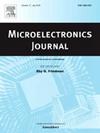A multi-channel OOK/BFSK transmitter with FoM of 99.99/91.2 and HD3/5 <−40 dBc
IF 1.9
3区 工程技术
Q3 ENGINEERING, ELECTRICAL & ELECTRONIC
引用次数: 0
Abstract
A 423.5–450 MHz low-power OOK/BFSK wireless transmitter (TX) is presented for biomedical applications. The TX utilizes injection locking, frequency multiplication, and harmonic rejection techniques. A frequency synthesizer based on low-frequency phase rotation enables multi-channel support and BFSK modulation. High-frequency quantization noise introduced by the delta-sigma modulator (DSM) is filtered out using an N-path filter and dual multi-phase injection-locked ring oscillators (ILROs). Finally, a harmonic-rejection edge combiner (HREC) is used to achieve 5X frequency multiplication, effectively lowering the operating frequency of other circuits and significantly reducing the system’s power consumption. The HREC provides rejection of the / harmonics while generating the desired carrier frequency. The TX is designed using a 65 nm CMOS process with a core area of 0.0625 . The simulation results show that the TX consumes 985 W at 1 V supply voltage and can provide −6.62 dBm output power to a load without any on-chip or off-chip inductance, which reduces the chip area. The TX achieves −40 dBc rejection for both and harmonics, supports data rates of 45/6 Mbps under OOK/BFSK modulation, respectively, achieving energy efficiency of 21.8/164 pJ/bit and FoM of 99.99/91.2.
一种多通道OOK/BFSK发射机,FoM为99.99/91.2,HD3/5 <−40 dBc
提出了一种用于生物医学应用的423.5-450 MHz低功耗OOK/BFSK无线发射机(TX)。TX采用注入锁定、倍频和谐波抑制技术。基于低频相位旋转的频率合成器支持多通道和BFSK调制。利用n路滤波器和双多相注入锁环振荡器(ILROs)滤除由δ - σ调制器(DSM)引入的高频量化噪声。最后,采用抑制谐波边缘合成器(HREC)实现了5倍的倍频,有效降低了其他电路的工作频率,显著降低了系统功耗。HREC在产生所需载波频率的同时提供抑制第三/第五次谐波。TX采用65纳米CMOS工艺设计,核心面积为0.0625 mm2。仿真结果表明,在1 V电源电压下,TX的功耗为985 μW,可以为50Ω负载提供−6.62 dBm的输出功率,而无需片内或片外电感,从而减小了芯片面积。在OOK/BFSK调制下,TX实现了3次和5次谐波抑制<;−40 dBc,分别支持45/6 Mbps的数据速率,实现了21.8/164 pJ/bit的能量效率和99.99/91.2的FoM。
本文章由计算机程序翻译,如有差异,请以英文原文为准。
求助全文
约1分钟内获得全文
求助全文
来源期刊

Microelectronics Journal
工程技术-工程:电子与电气
CiteScore
4.00
自引率
27.30%
发文量
222
审稿时长
43 days
期刊介绍:
Published since 1969, the Microelectronics Journal is an international forum for the dissemination of research and applications of microelectronic systems, circuits, and emerging technologies. Papers published in the Microelectronics Journal have undergone peer review to ensure originality, relevance, and timeliness. The journal thus provides a worldwide, regular, and comprehensive update on microelectronic circuits and systems.
The Microelectronics Journal invites papers describing significant research and applications in all of the areas listed below. Comprehensive review/survey papers covering recent developments will also be considered. The Microelectronics Journal covers circuits and systems. This topic includes but is not limited to: Analog, digital, mixed, and RF circuits and related design methodologies; Logic, architectural, and system level synthesis; Testing, design for testability, built-in self-test; Area, power, and thermal analysis and design; Mixed-domain simulation and design; Embedded systems; Non-von Neumann computing and related technologies and circuits; Design and test of high complexity systems integration; SoC, NoC, SIP, and NIP design and test; 3-D integration design and analysis; Emerging device technologies and circuits, such as FinFETs, SETs, spintronics, SFQ, MTJ, etc.
Application aspects such as signal and image processing including circuits for cryptography, sensors, and actuators including sensor networks, reliability and quality issues, and economic models are also welcome.
 求助内容:
求助内容: 应助结果提醒方式:
应助结果提醒方式:


